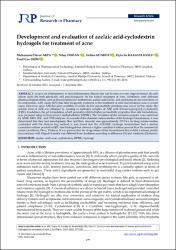| dc.contributor.author | Arpa, Muhammet Davut | |
| dc.contributor.author | Doğan, Nilay | |
| dc.contributor.author | Gündüz, Melisa | |
| dc.contributor.author | Karavelioğlu, Elçin Su | |
| dc.contributor.author | Erim, Ümit Can | |
| dc.date.accessioned | 2024-03-08T10:00:05Z | |
| dc.date.available | 2024-03-08T10:00:05Z | |
| dc.date.issued | 2024 | en_US |
| dc.identifier.citation | Arpa, M. D., Doğan, N., Gündüz, M., Karavelioğlu, E. S. ve Erim, Ü. C. (2024). Development and evaluation of azelaic acid-cyclodextrin hydrogels for treatment of acne. Journal of Research in Pharmacy, 28(1), 177-190. https://dx.doi.org/10.29228/jrp.686 | en_US |
| dc.identifier.issn | 2630-6344 | |
| dc.identifier.uri | https://dx.doi.org/10.29228/jrp.686 | |
| dc.identifier.uri | https://hdl.handle.net/20.500.12511/12350 | |
| dc.description.abstract | Acne is an inflammatory or non-inflammatory disease that can be seen at every stage of human life and affects daily life both physically and psychologically. In the topical treatment of acne, substances with different pharmacological effects such as benzoyl peroxide, isotretinoin, azelaic acid (AZE), and erythromycin are used alone or in combination. AZE cream (20%) has been frequently preferred in the treatment of mild and moderate acne in recent years. However, since AZE has poor solubility in water, its low permeability problems may occur. In this study, the soluble form of AZE was obtained by forming an inclusion complex of AZE with 2-hydroxypropyl β-cyclodextrin (HβC). In addition, the gel formulation, which generally exhibits higher permeability properties than oily formulations, was prepared using hydroxypropyl methylcellulose (HPMC). The formation of the inclusion complex was confirmed by NMR, XRD, DSC, and FTIR analyses. As a result of the characterization studies of the hydrogel formulations, it was determined that they had pseudoplastic flow and their viscosity was approximately 220 Pa.s. In drug release studies conducted with the dialysis bag method, it was found that the AZE-HβC hydrogel formulations had a similar cumulative release percent as HβC-free hydrogels but showed a higher cumulative release percent than the commercial cream (Azelderm, Orva, Türkiye). It was proven that the drug release of the formulations that exhibit a release profile in accordance with Higuchi kinetics was different from Azelderm according to difference (f1) and similarity (f2) factors. | en_US |
| dc.language.iso | eng | en_US |
| dc.publisher | Marmara University | en_US |
| dc.rights | info:eu-repo/semantics/openAccess | en_US |
| dc.subject | Acne | en_US |
| dc.subject | Azelaic Acid | en_US |
| dc.subject | Cyclodextrin | en_US |
| dc.subject | HPMC | en_US |
| dc.subject | Hydrogel | en_US |
| dc.title | Development and evaluation of azelaic acid-cyclodextrin hydrogels for treatment of acne | en_US |
| dc.type | article | en_US |
| dc.relation.ispartof | Journal of Research in Pharmacy | en_US |
| dc.department | İstanbul Medipol Üniversitesi, Eczacılık Fakültesi, Eczacılık Teknolojisi Bölümü, Farmasötik Teknoloji Ana Bilim Dalı | en_US |
| dc.department | İstanbul Medipol Üniversitesi, Eczacılık Fakültesi, Temel Eczacılık Bilimleri Bölümü, Analitik Kimya Ana Bilim Dalı | en_US |
| dc.authorid | 0000-0001-9290-2404 | en_US |
| dc.authorid | 0009-0006-3223-0275 | en_US |
| dc.authorid | 0000-0002-4121-588X | en_US |
| dc.identifier.volume | 28 | en_US |
| dc.identifier.issue | 1 | en_US |
| dc.identifier.startpage | 177 | en_US |
| dc.identifier.endpage | 190 | en_US |
| dc.relation.publicationcategory | Makale - Uluslararası Hakemli Dergi - Kurum Öğretim Elemanı | en_US |
| dc.identifier.doi | 10.29228/jrp.686 | en_US |
| dc.institutionauthor | Arpa, Muhammet Davut | |
| dc.institutionauthor | Doğan, Nilay | |
| dc.institutionauthor | Gündüz, Melisa | |
| dc.institutionauthor | Karavelioğlu, Elçin Su | |
| dc.institutionauthor | Erim, Ümit Can | |
| dc.identifier.wos | 001167297700014 | en_US |
| dc.identifier.scopus | 2-s2.0-85185438413 | en_US |
| dc.identifier.scopusquality | Q3 | en_US |


















